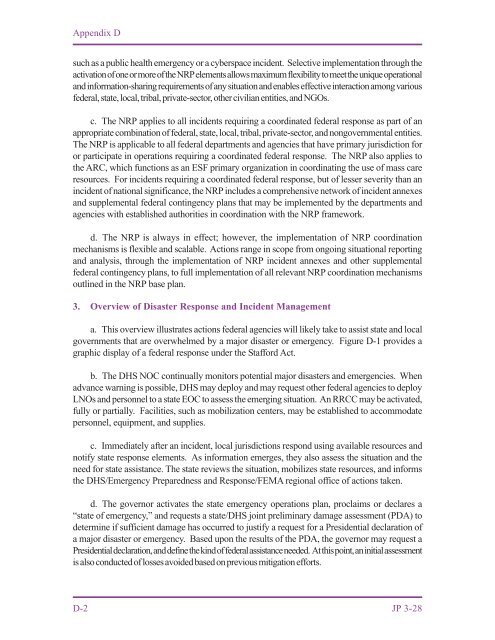JP 3-28, Civil Support - Federation of American Scientists
JP 3-28, Civil Support - Federation of American Scientists
JP 3-28, Civil Support - Federation of American Scientists
You also want an ePaper? Increase the reach of your titles
YUMPU automatically turns print PDFs into web optimized ePapers that Google loves.
Appendix D<br />
such as a public health emergency or a cyberspace incident. Selective implementation through the<br />
activation <strong>of</strong> one or more <strong>of</strong> the NRP elements allows maximum flexibility to meet the unique operational<br />
and information-sharing requirements <strong>of</strong> any situation and enables effective interaction among various<br />
federal, state, local, tribal, private-sector, other civilian entities, and NGOs.<br />
c. The NRP applies to all incidents requiring a coordinated federal response as part <strong>of</strong> an<br />
appropriate combination <strong>of</strong> federal, state, local, tribal, private-sector, and nongovernmental entities.<br />
The NRP is applicable to all federal departments and agencies that have primary jurisdiction for<br />
or participate in operations requiring a coordinated federal response. The NRP also applies to<br />
the ARC, which functions as an ESF primary organization in coordinating the use <strong>of</strong> mass care<br />
resources. For incidents requiring a coordinated federal response, but <strong>of</strong> lesser severity than an<br />
incident <strong>of</strong> national significance, the NRP includes a comprehensive network <strong>of</strong> incident annexes<br />
and supplemental federal contingency plans that may be implemented by the departments and<br />
agencies with established authorities in coordination with the NRP framework.<br />
d. The NRP is always in effect; however, the implementation <strong>of</strong> NRP coordination<br />
mechanisms is flexible and scalable. Actions range in scope from ongoing situational reporting<br />
and analysis, through the implementation <strong>of</strong> NRP incident annexes and other supplemental<br />
federal contingency plans, to full implementation <strong>of</strong> all relevant NRP coordination mechanisms<br />
outlined in the NRP base plan.<br />
3. Overview <strong>of</strong> Disaster Response and Incident Management<br />
a. This overview illustrates actions federal agencies will likely take to assist state and local<br />
governments that are overwhelmed by a major disaster or emergency. Figure D-1 provides a<br />
graphic display <strong>of</strong> a federal response under the Stafford Act.<br />
b. The DHS NOC continually monitors potential major disasters and emergencies. When<br />
advance warning is possible, DHS may deploy and may request other federal agencies to deploy<br />
LNOs and personnel to a state EOC to assess the emerging situation. An RRCC may be activated,<br />
fully or partially. Facilities, such as mobilization centers, may be established to accommodate<br />
personnel, equipment, and supplies.<br />
c. Immediately after an incident, local jurisdictions respond using available resources and<br />
notify state response elements. As information emerges, they also assess the situation and the<br />
need for state assistance. The state reviews the situation, mobilizes state resources, and informs<br />
the DHS/Emergency Preparedness and Response/FEMA regional <strong>of</strong>fice <strong>of</strong> actions taken.<br />
d. The governor activates the state emergency operations plan, proclaims or declares a<br />
“state <strong>of</strong> emergency,” and requests a state/DHS joint preliminary damage assessment (PDA) to<br />
determine if sufficient damage has occurred to justify a request for a Presidential declaration <strong>of</strong><br />
a major disaster or emergency. Based upon the results <strong>of</strong> the PDA, the governor may request a<br />
Presidential declaration, and define the kind <strong>of</strong> federal assistance needed. At this point, an initial assessment<br />
is also conducted <strong>of</strong> losses avoided based on previous mitigation efforts.<br />
D-2<br />
<strong>JP</strong> 3-<strong>28</strong>

















